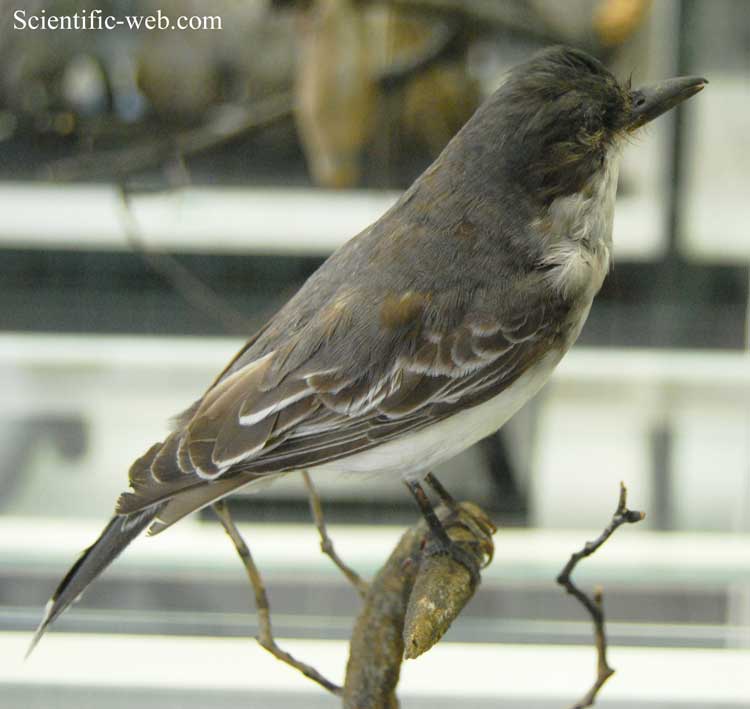
Tyrannus tyrannus, Photo: Michael Lahanas
Superregnum: Eukaryota
Regnum: Animalia
Subregnum: Eumetazoa
Cladus: Bilateria
Cladus: Nephrozoa
Superphylum: Deuterostomia
Phylum: Chordata
Cladus: Craniata
Subphylum: Vertebrata
Infraphylum: Gnathostomata
Superclassis: Tetrapoda
Cladus: Reptiliomorpha
Cladus: Amniota
Classis: Reptilia
Cladus: Eureptilia
Cladus: Romeriida
Subclassis: Diapsida
Cladus: Sauria
Infraclassis: Archosauromorpha
Cladus: Crurotarsi
Divisio: Archosauria
Subsectio: Ornithodira
Subtaxon: Dinosauromorpha
Cladus: Dinosauria
Ordo: Saurischia
Cladus: Eusaurischia
Cladus: Theropoda
Cladus: Neotheropoda
Infraclassis: Aves
Ordo: Passeriformes
Subordo: Tyranni
Infraordo: Tyrannides
Parvordo: Tyrannida
Familia: Tyrannidae
Subfamilia: Tyranninae
Genus: Tyrannus
Species: Tyrannus tyrannus
Name
Tyrannus tyrannus (Linnaeus, 1758)
Synonyms
Lanius tyrannus (protonym)
References
Linnaeus, C. 1758. Systema Naturae per regna tria naturae, secundum classes, ordines, genera, species, cum characteribus, differentiis, synonymis, locis. Editio Decima, Reformata. Tomus I. Holmiæ (Stockholm): impensis direct. Laurentii Salvii. 824 pp. DOI: 10.5962/bhl.title.542 [first availability: page 94] BHL Reference page.
Vernacular names
العربية: عصفور الملك الشرقي
български: Източен кралски тиран
català: Tirà de l'est
čeština: Tyran královský
Cymraeg: Teyrnaderyn y Dwyrain
dansk: Østlig Kongetyran
Deutsch: Königstyrann
English: Eastern Kingbird
español: Pitirre americano
فارسی: شاهمرغ شرقی
suomi: Pihatyranni
français: Tyran tritri
magyar: Keleti királygébics
italiano: Tiranno orientale
日本語: オウサマタイランチョウ
ಕನ್ನಡ: ಪೂರ್ವ ರಾಜನೊಣಹಿಡುಕ
Nederlands: Koningstiran
norsk: Østkongetyrann
Diné bizaad: Haʼaʼaahdę́ę́ʼ chʼiyíítʼogii
polski: Tyran północny
português do Brasil: Suiriri-valente
português: Suiriri-valente
русский: Королевский тиранн
slovenčina: Postriežkar kráľovský
svenska: Östlig kungstyrann
українська: Тиран королівський
中文: 东王霸鹟
The eastern kingbird (Tyrannus tyrannus) is a large tyrant flycatcher native to the Americas. The bird is predominantly dark gray with white underbelly and pointed wings.[2] Eastern kingbirds are conspicuous and are commonly found in open areas with scattered trees and bushes, where they perch while foraging for insects.[3] The Eastern kingbird is migratory, with its breeding range spread across North America and its wintering range in Central and South America.[1]
Taxonomy
The eastern kingbird was described by the Swedish naturalist Carl Linnaeus in 1758 in the tenth edition of his Systema Naturae under the binomial name of Lanius tyrannus.[4] The present genus Tyrannus was introduced in 1799 by the French naturalist Bernard Germain de Lacépède with the eastern kingbird as the type species.[5] The species is monotypic; no subspecies are recognised.[6]
Description
Adults are grey-black on the upperparts with light underparts; they have a long black tail with a white end and long, pointed wings. They have a red patch on their crown, seldom seen. They are of average size for a kingbird, at 19–23 cm (7.5–9.1 in), 33–38 cm (13–15 in) across the wings and weighing 33–55 g (1.2–1.9 oz).[7]
The call is a high-pitched, buzzing and unmusical chirp, frequently compared to an electric fence.[8]
Distribution and range
Nest and eggs
Eggs, Collection Museum Wiesbaden
Their breeding habitat is open areas across North America. They make a sturdy cup nest in a tree or shrub, sometimes on top of a stump or pole. These birds aggressively defend their territory, even against much larger birds.[9]
These birds migrate in flocks to South America. There are three European records, two from Ireland in October 2012 and September 2013, and one from Scotland in September 2016.
Behavior
Breeding
Some eastern kingbirds place their nests in the open, while others hide their nests well. Eastern kingbirds in southern British Columbia may nest in open fields, in shrubs over open water, high up in trees, and even in the tops of small stumps. Both male and female participate in nest defense, but females may stay on well-hidden nests longer than females with open nests, who may leave nests earlier to chase away predators. Those pairs nesting in the open may be able to see predators coming earlier and rely on aggressive behavior to protect their young.
The aggressive behavior of eastern kingbirds has been shown to keep ravens and crows from finding experimental nests placed near kingbird nests. Similar experimental nests placed further from the kingbird nests were more likely to be spotted by crows and ravens. Blue jays, American crows, squirrels, and tree-climbing snakes are on occasion kingbird nest predators. American kestrels likely prey on the adults.[10]
Food and feeding
Eastern kingbirds wait on an open perch and fly out to catch insects in flight, sometimes hovering to pick prey off vegetation. They also eat berries and fruit, mainly in their wintering areas.[11]
Footnotes
BirdLife International (2016). "Tyrannus tyrannus". IUCN Red List of Threatened Species. 2016: e.T22700506A93781244. doi:10.2305/IUCN.UK.2016-3.RLTS.T22700506A93781244.en. Retrieved 12 November 2021.
"Eastern Kingbird Life History, All About Birds, Cornell Lab of Ornithology". www.allaboutbirds.org.
Sibley, David Allen (2011). The Sibley Guide to Birds. Alfred A. Knopf. ISBN 978-0-679-45122-8.
Linnaeus, Carl (1758). Systema Naturae per regna tria naturae, secundum classes, ordines, genera, species, cum characteribus, differentiis, synonymis, locis (in Latin). Volume 1 (10th ed.). Holmiae:Laurentii Salvii. p. 94.
Lacépède, Bernard Germain de (1799). "Tableau des sous-classes, divisions, sous-division, ordres et genres des oiseux". Discours d'ouverture et de clôture du cours d'histoire naturelle (in French). Paris: Plassan. p. 5. Page numbering starts at one for each of the three sections.
Gill, Frank; Donsker, David, eds. (2017). "Tyrant flycatchers". World Bird List Version 7.3. International Ornithologists' Union. Retrieved 9 January 2018.
"Eastern Kingbird Life History, All About Birds, Cornell Lab of Ornithology". www.allaboutbirds.org.
"Eastern Kingbird - Sounds". Birds of North America Online – via Cornell.
"All About Birds: Eastern Kingbird". All About Birds. Cornell Lab of Ornithology. 2003. Retrieved 2008-08-12.
"Eastern Kingbird - Behavior". Birds of North America Online – via Cornell.
E.g. of Gumbo-limbo, Bursera simaruba (Foster 2007).
References
Foster, Mercedes S. (2007): The potential of fruiting trees to enhance converted habitats for migrating birds in southern Mexico. Bird Conservation International 17(1): 45–61. doi:10.1017/S0959270906000554 PDF fulltext
Retrieved from "http://en.wikipedia.org/"
All text is available under the terms of the GNU Free Documentation License

